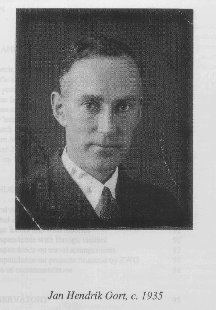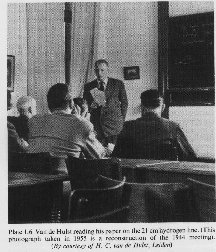
The great Dutch astronomer Jan Oort learned of Grote Reber's discoveries in
radio astronomy and realized that a radio spectral line would be an important
tool for discovering the structure of our galaxy. Oort had spent many years
studying the rotation and structure of the galaxy using optical means.
He was frustrated by the extensive clouds of dust lying in the galactic plane,
which block visible light. One can see only a few thousand light years towards
the galactic center because the light of distant stars is absorbed.
But radio waves will penetrate the dust and show us the galactic center and
indeed the opposite side of the galaxy. The importance of a spectral
line is that the frequency of the line will be shifted by the Doppler effect
which means that the velocity of the gas can be measured. One can then study
the differential rotation of the galaxy and estimate distances to gas clouds,
and thus map the distribution of matter in the galaxy.
 Oort assigned his student, H.C. Van de Hulst, the job of figuring out
what radio spectral lines might exist and what their frequencies would be.
Since hydrogen is the most abundant element in the universe, he started
his studies with hydrogen. He found that a "hyperfine" transition in the
ground state of neutral hydrogen would produce radiation in the radio range,
at a frequency of 1420 MHz, or about 21 cm wavelength.
In the ground state of hydrogen, the electron can have its magnetic moment
either parallel to that of the proton, or anti-parallel. The parallel state
has a little more energy, so a transition to the anti-parallel state
results in emission of 21 cm radiation.
Oort assigned his student, H.C. Van de Hulst, the job of figuring out
what radio spectral lines might exist and what their frequencies would be.
Since hydrogen is the most abundant element in the universe, he started
his studies with hydrogen. He found that a "hyperfine" transition in the
ground state of neutral hydrogen would produce radiation in the radio range,
at a frequency of 1420 MHz, or about 21 cm wavelength.
In the ground state of hydrogen, the electron can have its magnetic moment
either parallel to that of the proton, or anti-parallel. The parallel state
has a little more energy, so a transition to the anti-parallel state
results in emission of 21 cm radiation.
Van de Hulst's prediction was published in Dutch in Ned.Tijd.Natuurkunde,
vol.11, p210, 1945. An English translation is published in "Classics
in Radio Astronomy", by W.Sullivan, Reidel 1982.
Building a receiver to detect the predicted line proved to be a daunting
task. Grote Reber began design of such a receiver in 1947, but set it
aside because of changing jobs and moving to the east coast.
Dutch engineers worked on the problem, but the first successful detection
was by Ewen and Purcell at Harvard.
Credits: photos of Oort and Oort&van de Hulst from "The Letters and Papers of Jan Hendrik Oort",
by J.K.Katgert-Merkelijn, Kluwer, 1997.
Photo of van de Hulst reading paper from "The Evolution of Radio Astronomy" by J.S.Hey,
Science History Publications, 1973.